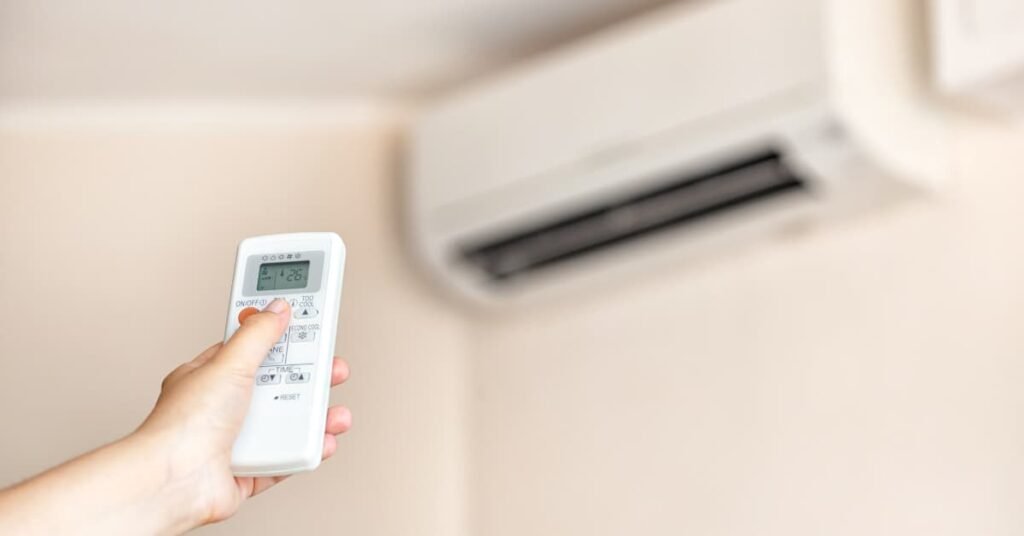What is Dry Mode in AC? And How It Works
Have you ever noticed the ‘Dry Mode’ on your air conditioner’s settings and wondered what it does?
It’s a little-known but incredibly handy feature present in many modern air conditioners.
If you’re curious about understanding how ‘Dry Mode’ creates a more comfortable indoor environment, you’re in the right place.
This guide explores the details of this setting, highlighting its unique features, benefits, and how it enhances the atmosphere in your home or office.
What is the Dry Mode on the air conditioner?
The “Dry Mode,” also known as the dehumidifying function in AC, lowers humidity without significantly affecting room temperature.
Unlike regular cooling, Dry Mode specifically targets and reduces excess moisture in the air.
Instead of continuous cooling, it cycles the compressor, allowing warm air to cool as it passes over the evaporator coils.
Cooling causes air moisture to condense on coils, collecting and dripping into a pan or draining system.
Dry Mode reduces humidity, creating a comfortable indoor environment without temperature drops by removing excess moisture.

How Does the Dry Mode Work?
When ‘Dry Mode’ is turned on in an AC, it takes a different approach from regular cooling.
Instead of just cooling the air, it focuses on reducing humidity while maintaining a comfortable temperature.
This cycles the compressor on and off, drawing in warm air to cool it over the coils, causing moisture to collect, like dew forming.
The collected water either drips into a tray or is drained out. This process lowers humidity levels, making the indoor environment more comfortable.
‘Dry Mode’ efficiently removes excess moisture, making indoor spaces more pleasant and healthy without drastically cooling the air.
Advantages of Using Dry Mode
Here’s a breakdown of the advantages of the Dry Mode in air conditioners given below:
Humidity Control
The Dry Mode in your air conditioner is like a superhero for reducing extra dampness in the air.
Imagine feeling all sticky and uncomfortable because the air is too moist.
This setting helps fix that problem by taking out the extra water in the air, making it feel cooler and much nicer. So, it helps the air be less wet and more comfy for you.
Energy Efficiency
When your air conditioner works in the Dry Mode, it doesn’t try to make things too cold. Because of this, it uses less energy than when it’s trying to make the room really chilly.
That means it’s a clever choice when you want to control the wetness in the air without using too much electricity.
Mold Prevention
Too much humidity is like a welcome sign for mold—it encourages it to grow. Mold is like the unwelcome guest that damages stuff and can make you sick.
But when your air conditioner is in the Dry Mode, it creates an environment that’s not cozy for mold.
So, it helps keep your place safer from these yucky, harmful things.
Dry Mode is a helpful friend in your AC, making the air more comfortable, saving energy, and preventing issues like mold.
When To Use Dry Mode?
Now, let’s break down the benefits of using the Dry Mode in different situations using comfort as a parameter:
Best for High Humidity or Rainy Seasons: Dry Mode is like a superhero when the air feels heavy and damp. Imagine those sticky, sweaty days or the times when it rains a lot. In these situations, there’s a lot of moisture in the air, making it feel extra muggy and uncomfortable.
The Dry Mode in your air conditioner is super effective during these times. It works to pull out the extra moisture, making the air less sticky and much nicer to breathe.
Better Sleep without the Chill: Imagine you want a cozy sleep without feeling too cold. The Dry Mode at night is like your bedtime buddy. It helps make the air less damp without turning your room icy. So, you can sleep comfortably without getting too cold under your blanket.
Perfect for Places with Medium Heat but High Humidity: Think about places where it’s not crazy hot, but it’s definitely sticky due to humidity. The Dry Mode is like a balancing act here. It helps handle the humidity without dropping the temperature too much.
Put simply, the Dry Mode in your air conditioner is a useful tool for different situations, comfortable sleep at night, or sticky yet not excessively hot areas. It’s like your secret weapon to make the air just right for you, wherever you are.

Tips for using Dry Mode effectively
Optimal Temperature Setting
When you’re using the Dry Mode on your AC, a great temperature range to aim for is between 24 to 26 degrees Celsius.
This temperature sweet spot balances humidity control with comfort.
It’s not too cold, but just cool enough to help remove excess moisture from the air, making your space feel more pleasant.
Regular Maintenance
Making sure your air conditioner gets regular check-ups is really important to keep the Dry Mode working well.
Think of it like taking care of your AC’s health!
Cleaning filters and coils is crucial because they help remove excess moisture from the air. When they’re clean, your AC works better at getting rid of humidity.
Room Size Considerations
The size of the room you’re using your AC in can make a difference in how well the Dry Mode works.
In bigger spaces, just one AC might not be enough to dry the air effectively.
You might need more than one unit or a special dehumidification system that works for the whole area.
It’s like using the right tool for the right job—having the correct setup for the room size helps ensure the Dry Mode does its job properly, no matter how large the space is.
Dry Mode Vs. Standard Cooling Mode
In the Dry Mode, the air conditioner primarily works to dehumidify the room by removing moisture. It cools the air to condense moisture and reheats it before exiting the unit. This process helps to reduce the humidity levels without significantly lowering the temperature in the room.
And the Standard Cooling Mode focuses on cooling the room by lowering both the temperature and humidity levels. It operates by cooling the air and then expelling it back into the room.
In terms of energy consumption, the Dry Mode generally uses less energy compared to the Standard Cooling Mode. This is because it doesn’t need the air conditioner to cool the air as much as the Cooling Mode, reducing power usage.
When choosing the appropriate mode for different situations, it’s important to consider the desired temperature and humidity levels.
Conclusion
The dry mode on an air conditioner is a useful feature that helps remove excess humidity from the air without cooling it significantly.
It helps create a more comfortable indoor environment by reducing dampness and preventing the growth of mold and mildew.
Understanding the dry mode works can optimize your air conditioner usage and improve performance.






